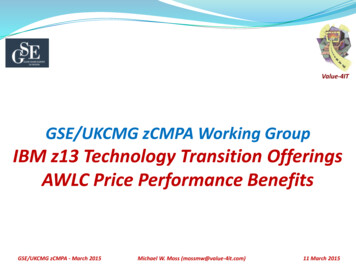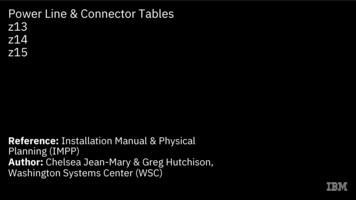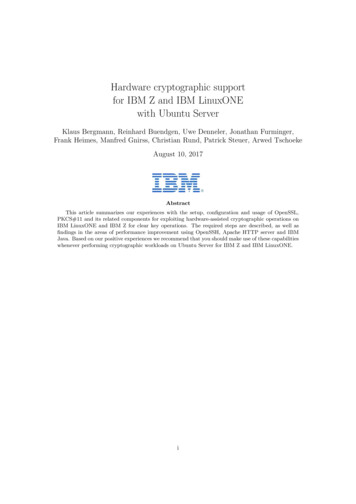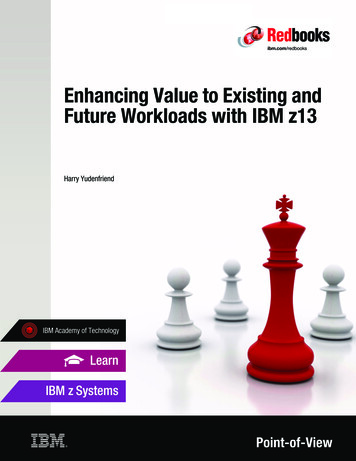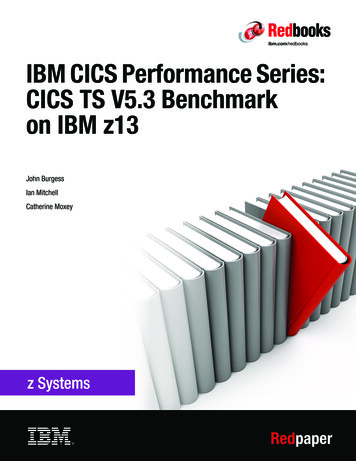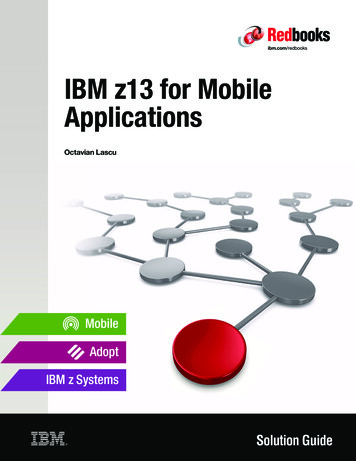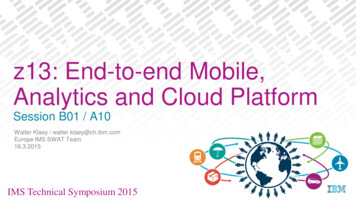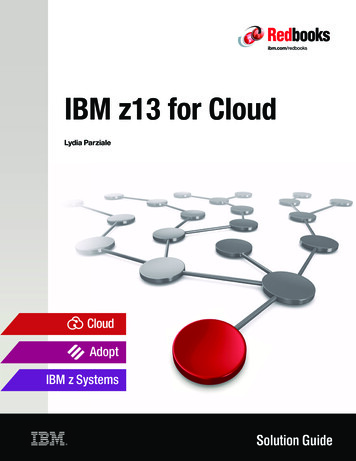
Transcription
IBM z13 for CloudLydia ParzialeCloudAdoptIBM z SystemsSolution Guide
IBM z13 for CloudIBM Redbooks Solution GuideCloud computing represents a shift to a more user-centered computing model where a layer of servicessitting on an infrastructure decouples core business functions from the delivery of the underlyingtechnology. IBM recognizes that multiple ways exist to deliver IT capabilities, which include traditionalsoftware, hardware, and networking approaches, pre-integrated systems and appliances, and newbreakthroughs that are provided as a service. This IBM Redbooks Solution Guide offers moreinformation. The IBM z13 is based on a heterogeneous infrastructure, with end-to-end managementcapabilities for flexible delivery of high value services. Because of this, it is ideal for meeting therequirements of the IBM Cloud Computing Reference Architecture (CCRA). IBM CCRA (Figure 1) definesfundamental architectural elements which constitute a cloud computing environment. The requirement isfor all these infrastructure components to be managed from a single, central Common Cloud ManagementPlatform and be able to place instances of each cloud service on the corresponding infrastructure.Figure 1 IBM Cloud Computing Reference Architecture infrastructureIBM z13 for Cloud1
Did you know?The transformation to cloud computing quickened the adaptation of its key enabling technologies, such asvirtualization. For clients looking to lower costs, perhaps by deferring capital expenditures or off-loadingnon-core IT processes, cloud computing presents a way to do so while still providing services anddeploying them quickly. Cloud computing is becoming more widely used as technologies, such asvirtualization, automation, and provisioning, mature. Because IBM z13, with its “shared everythinginfrastructure,” offers a fully virtualized system, integrating a cloud computing deployment as part of theexisting IT optimization strategy and roadmap becomes easier.The key benefits that are provided through cloud computing are virtualization, standardization andautomation.Virtualization Higher utilizationEconomy-of-scale benefitsLower capital expenseLower operating expenseStandardization Easier accessFlexible pricingReuse and sharingEasier integrationAutomation Faster cycle timesLower support costsOptimized utilizationImproved complianceOptimized securityBetter user experienceBusiness valueCloud computing on IBM z13 builds on the industry’s leading virtualization technology that usesvirtualization, standardization, and automation to free the operational budget for new investments. Thistechnology also allows you to optimize new investments for direct business benefits. The IBM z13provides the following features: A highly scalable heterogeneous pool of virtualized resources that are managed in a single system On-demand activation, allocation, prioritization, and retiring of resources, and automation of servicedelivery Maximized utilization of resources for improved return on investment (ROI) and lower cost of servicedelivery Increased levels of security, resiliency, and manageability to create a cloud environment that isenterprise-ready More processing capacity, multithreading, and larger memory to consolidate different applicationswith less physical infrastructureIBM z13 for Cloud2
IBM z13, as the IT industry’s first multi-architecture cloud solution, provides these benefits: Higher utilization:– Up to 100% CPU utilization– Shared everything architecture– Hosting of thousands of mixed workloads– Multithreading capability Increased productivity:– Single point of control for a heterogeneous infrastructure at a platform level, with Unified ResourceManager– Efficient, rapid provisioning– Superior workload management that is enabled with Unified Resource Manager– Workload optimization with fit-for-purpose approach– Collocating applications where industry-leading IBM z/OS transaction and data services run More efficient data center:– Less power and cooling– Less floor space– Fewer parts to manage Greater reliability and availability:– Built-in hardware redundancy– Decades of reliability, availability, and serviceability (RAS) innovation– Capacity and backup on demand– Decades-proven virtualization security protecting sensitive data and critical business processes inthe cloud– Resiliency management and fewer points of failure Security:– Extending IBM z Systems security to a private network across heterogeneous resourcesSolution overviewAs an example of this cloud solution, we use a telecom provider that selected the IBM z Systems platformfor the provider's Linux operating system consolidation and virtualization. That company wants to build acloud platform but also wants to reduce its cost of operation and overall data center footprint. Thecompany's strategy is to improve provisioning time for its business support system (BSS) and operationalsupport system (OSS) to satisfy server requests of its users.IBM z13 for Cloud3
Solution architectureFigure 2 is an architectural overview for a cloud solution using Linux on z Systems.Figure 2 Overview of cloud solution on Linux for z SystemsIn this example, the technology described in the following lists can be used.Consolidated hardware , operating system, and software infrastructure IBM z13IBM z/VM 6.3Red Hat Enterprise Linux or SUSE Linux Enterprise Servers on the IBM z System platformIBM protecTIER Gateway TS7680 - Deduplication and Virtual Tape LibraryCloud (IBM SmartCloud ) Automation with cloud: IBM Tivoli System AutomationAutomated provisioning: Tivoli Provisioning ManagerService Lifecycle Management: IBM SmartCloud Control DeskIBM z13 for Cloud4
Build monitoring and system management IBM Tivoli OMEGAMON on z/VM and Linux: Information about your Linux instances running asz/VM guests and the Linux workloads reveal how they are performing and impacting z/VM and eachother:oCompare Linux operations side by side with detailed performance metrics.oData collection from the Performance Toolkit for VM (PTK is a prerequisite) complements datacollection by the IBM Tivoli Monitoring for Linux for z Systems agent.oWith new Dynamic Workspace Linking, you can easily navigate between Tivoli Enterprise Portalworkspaces.oView and monitor workloads for virtual machines, groups, response times and LPAR reporting,and view reports about z/VM and Linux usage of resources such as CPU utilization, storage,mini-disk,s and TCP/IP.oHigh-level views help executives understand how systems performance influences business andthe bottom line.oWith granular views, IT staffs can more easily track complex problems that span multiple systemsand platforms and share related information.IBM Wave for z/VM: IBM Wave is a new virtualization management product for z/VM and Linux virtualservers that uses visualization to dramatically automate and simplify administrative and managementtasks:oAutomate, simplify management and monitor virtual servers and resources, all from a singledashboard.oPerform complex virtualization tasks in a fraction of the time compared to manual execution.oProvision virtual resources (Servers, Network, Storage) to accelerate the transformation to cloudinfrastructure.oUse advanced z/VM management capabilities such as Live Guest Relocation with a few clicks.oDelegate responsibility and provide more self service capabilities to the appropriate teams.IBM z13 for Cloud5
Usage scenariosThis scenario is for the energy and utilities industry : SAP Cloud and Automation solution on z Systems. Inthis scenario, the fictional energy and utilities company, Fictional Energy E1, chooses the z Systemsplatform with its SAP application running on Linux for z Systems and database on IBM z/OS . Energy E1wants to reduce the time spent to copy and refresh complete SAP systems from days to hours with acloud solution and SAP system automation, which can automate, standardize, and increase the speed ofday-to-day operations for SAP systems, reducing the risk of mistakes caused by human error. Thecompany wants to reduce time spent on complex, repetitive tasks, freeing up skilled staff for higher valuework and deliver higher operational efficiency, helping to slash costs and accelerate the time-to-valueratio for new workloads.Step 1: Build a virtual platform IBM z13IBM z/VM 6.3Red Hat Enterprise Linux or SUSE Linux Enterprise Server on z Systems platformIBM DB2 for z/OS IBM Database Provisioning System (DPS)ooo Web application JCL EngineDatabase ManagementIntegrated with DB2 Cloning ToolIBM DB2 Cloning Tool for z/OS: The DB2 Cloning Tool automates the cloning process to provideusable DB2 clones within minutes, boosting efficiency and freeing up DBA time.oQuickly clones DB2 subsystems, DB2 table spaces, or index spaces to create up-to-date testenvironments.oAutomates the cloning process to provide usable DB2 clones within minutes.oClones a DB2 subsystem by renaming and cataloging the data sets, fixing the volume internals,and updating the DB2 internal control information.oFast copy technology quickly copies DB2 data sets within a subsystem or to a differentsubsystem.oAutomates the cloning process using any volume level technology (such as IBM FlashCopy ) toclone DB2 subsystems and any data set copy technology (such as FlashCopy) to clone table andindex spaces, and automatically translates object IDs to simplify and automate refresh of data.SAP NetWeaver Landscape Virtualization Management (LVM): By streamlining and automatingcritical business processes, SAP NetWeaver LVM software enables your IT department to focus onresponding to new initiatives, controlling IT costs, and differentiating your business.ooooManage your SAP landscape in physical and virtualized environments.Central management point for your SAP landscape, start/stop, and mass operations.Automate standard, day-to-day administrative and lifecycle management tasks.Save time, effort, and money by automating copy, clone and refresh.Step 2: Build IBM Entry Cloud Solution for SAP with automated lifecycle management operations SAP System Clone: Provision a fresh SAP system based on a new system copy.SAP System Copy: Create a customized SAP system based on existing system.SAP System Refresh: Copy DB content from PRD to Non-PRD including post processing.Create an extra Dialog instance: Add extra application server instances, for example for monthlyclosing.IBM z13 for Cloud6
Figure 3 illustrates the solution architecture overview.Figure 3 Automate SAP System Copy with IBM Entry Cloud Solution for SAPThe IBM Entry Cloud Configuration solution automates complex tasks typically performed byadministrators of databases, operating systems, storage systems, and SAP Basis. When combined withSAP NetWeaver LVM, the configuration can reduce the time spent to copy and refresh complete SAPsystems from days to hours. The high degree of automation also improves the quality and efficiency ofSAP operations. The Linux on z Systems, IBM Entry Cloud Configuration solution is the ideal productivitytool for any IT organization running SAP Business Suite on the IBM z13 with IBM DB2 for z/OS. It iswell-suited for computer services organizations hosting SAP systems for their clients, and for any ITorganization seeking to run its SAP operations with z Systems in an on-premises, self-managed, cloudcomputing environment. Figure 4 shows the added value of this solution and how the solution reducesoperation and administration time when compared to traditional operations.Figure 4 Value delivered by cloud, based on IBM internal use; might vary depending on underlyinginfrastructureIBM z13 for Cloud7
IntegrationThe solution integrates well with technologies and transactional and information services by using thefollowing products: IBM z13Red Hat Enterprise Linux on z SystemsSUSE Linux Enterprise Server on z SystemsSAP AutomationIBM z/OSIBM HTTP serverIBM WebSphere Application ServerIBM DB2IBM Wave for z/VMIBM SmartCloudIBM DataPowerIBM MobileFirst Platform Foundation (formerly IBM Worklight )Ordering informationContact your IBM representative for IBM z13 ordering information.Related informationFor more information, see the following documents: IBM z13 Technical Introduction, 48250.html IBM z13 product pagehttp://www.ibm.com/systems/z/hardware/z13.html IBM Offering Information page (announcement letters and sales .htmlIBM z13 for Cloud8
NoticesThis information was developed for products and services offered in the U.S.A.IBM may not offer the products, services, or features discussed in this document in other countries. Consult your localIBM representative for information on the products and services currently available in your area. Any reference to anIBM product, program, or service is not intended to state or imply that only that IBM product, program, or service maybe used. Any functionally equivalent product, program, or service that does not infringe any IBM intellectual propertyright may be used instead. However, it is the user's responsibility to evaluate and verify the operation of any non-IBMproduct, program, or service. IBM may have patents or pending patent applications covering subject matter describedin this document. The furnishing of this document does not give you any license to these patents. You can sendlicense inquiries, in writing, to:IBM Director of Licensing, IBM Corporation, North Castle Drive, Armonk, NY 10504-1785 U.S.A.The following paragraph does not apply to the United Kingdom or any other country where such provisions areinconsistent with local law : INTERNATIONAL BUSINESS MACHINES CORPORATION PROVIDES THISPUBLICATION "AS IS" WITHOUT WARRANTY OF ANY KIND, EITHER EXPRESS OR IMPLIED, INCLUDING, BUTNOT LIMITED TO, THE IMPLIED WARRANTIES OF NON-INFRINGEMENT, MERCHANTABILITY OR FITNESSFOR A PARTICULAR PURPOSE. Some states do not allow disclaimer of express or implied warranties in certaintransactions, therefore, this statement may not apply to you. This information could include technical inaccuracies ortypographical errors. Changes are periodically made to the information herein; these changes will be incorporated innew editions of the publication. IBM may make improvements and/or changes in the product(s) and/or the program(s)described in this publication at any time without notice.Any references in this information to non-IBM Web sites are provided for convenience only and do not in any mannerserve as an endorsement of those Web sites. The materials at those Web sites are not part of the materials for thisIBM product and use of those Web sites is at your own risk.IBM may use or distribute any of the information yousupply in any way it believes appropriate without incurring any obligation to you. Information concerning non-IBMproducts was obtained from the suppliers of those products, their published announcements or other publicly availablesources. IBM has not tested those products and cannot confirm the accuracy of performance, compatibility or anyother claims related to non-IBM products. Questions on the capabilities of non-IBM products should be addressed tothe suppliers of those products. This information contains examples of data and reports used in daily businessoperations. To illustrate them as completely as possible, the examples include the names of individuals, companies,brands, and products. All of these names are fictitious and any similarity to the names and addresses used by anactual business enterprise is entirely coincidental.Any performance data contained herein was determined in a controlled environment. Therefore, the results obtainedin other operating environments may vary significantly. Some measurements may have been made ondevelopment-level systems and there is no guarantee that these measurements will be the same on generallyavailable systems. Furthermore, some measurement may have been estimated through extrapolation. Actual resultsmay vary. Users of this document should verify the applicable data for their specific environment.COPYRIGHT LICENSE:This information contains sample application programs in source language, which illustrate programming techniqueson various operating platforms. You may copy, modify, and distribute these sample programs in any form withoutpayment to IBM, for the purposes of developing, using, marketing or distributing application programs conforming tothe application programming interface for the operating platform for which the sample programs are written. Theseexamples have not been thoroughly tested under all conditions. IBM, therefore, cannot guarantee or imply reliability,serviceability, or function of these programs. Copyright International Business Machines Corporation 2015. All rights reserved .Note to U.S. Government Users Restricted Rights -- Use, duplication or disclosure restricted byGSA ADP Schedule Contract with IBM Corp.IBM z13 for Cloud9
This document was created or updated on January 13, 2015.Send us your comments in one of the following ways:Use the online Contact us review form found at:ibm.com/redbooks Send your comments in an e-mail to:redbooks@us.ibm.com Mail your comments to:IBM Corporation, International Technical Support OrganizationDept. HYTD Mail Station P0992455 South RoadPoughkeepsie, NY 12601-5400 U.S.A. This document is available online at l .TrademarksIBM, the IBM logo, and ibm.com are trademarks or registered trademarks of International BusinessMachines Corporation in the United States, other countries, or both. These and other IBM trademarkedterms are marked on their first occurrence in this information with the appropriate symbol ( or ),indicating US registered or common law trademarks owned by IBM at the time this information waspublished. Such trademarks may also be registered or common law trademarks in other countries. Acurrent list of IBM trademarks is available on the Web at http://www.ibm.com/legal/copytrade.shtmlThe following terms are trademarks of the International Business Machines Corporation in the UnitedStates, other countries, or both:DB2 FlashCopy IBM IBM SmartCloud OMEGAMON Redbooks Redbooks (logo) System z Tivoli WebSphere Worklight z13 z/OS z System z/VM The following terms are trademarks of other companies:Linux is a trademark of Linus Torvalds in the United States, other countries, or both.Other company, product, or service names may be trademarks or service marks of others.IBM z13 for Cloud10
The IBM z13 is based on a heterogeneous infrastructure, with end-to-end management capabilities for flexible delivery of high value services. Because of this, it is ideal for meeting the requirements of the IBM Cloud Computing Reference Architecture (CCRA). IBM CCRA (Figure 1) defines . Flexible pricing
